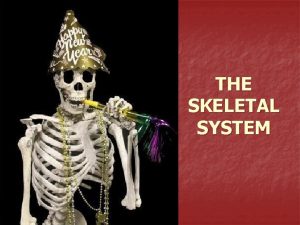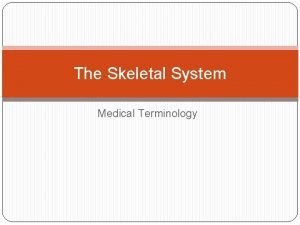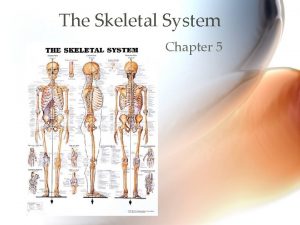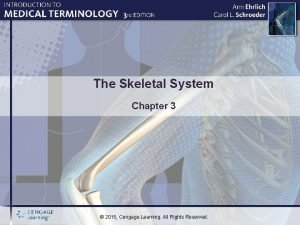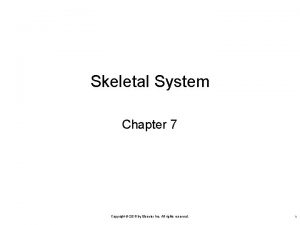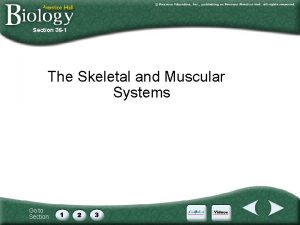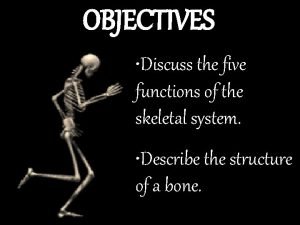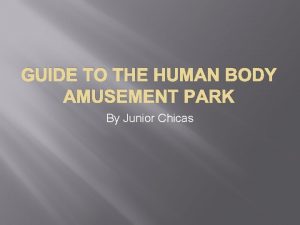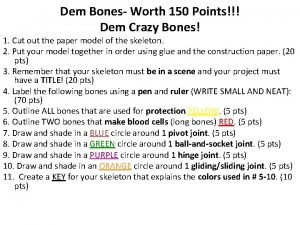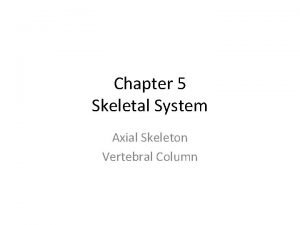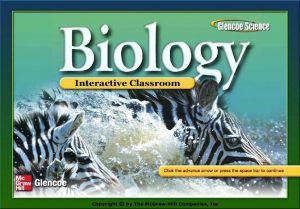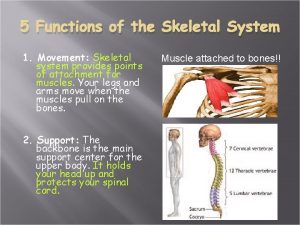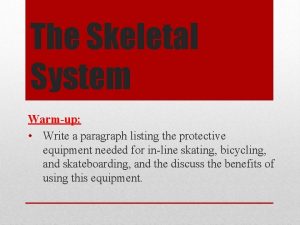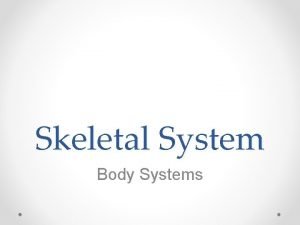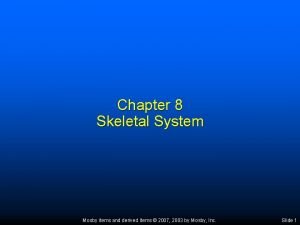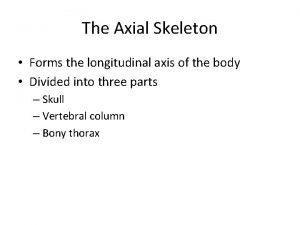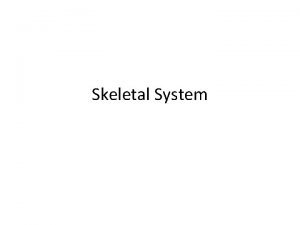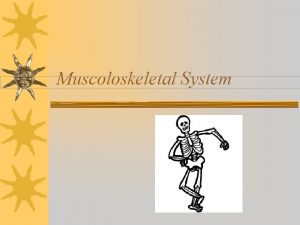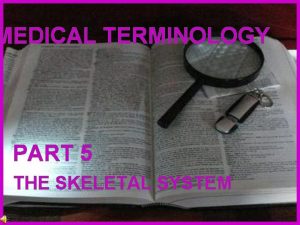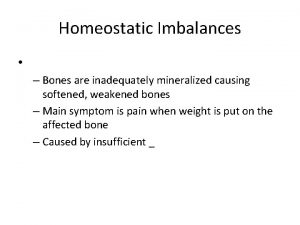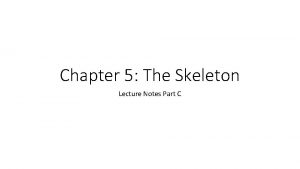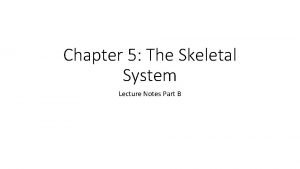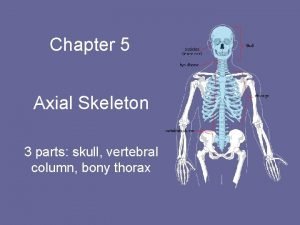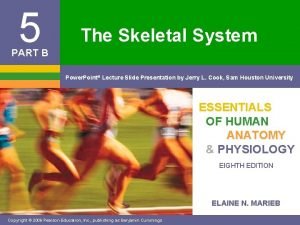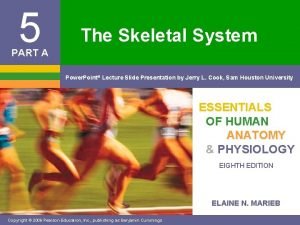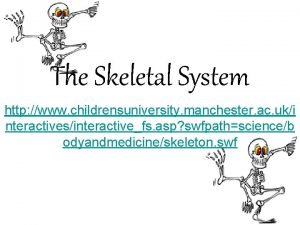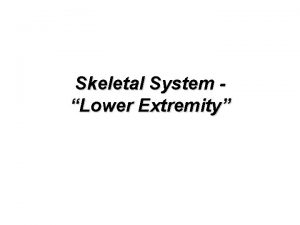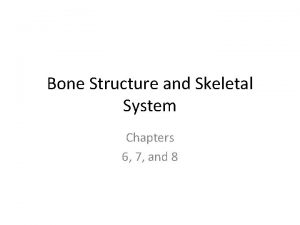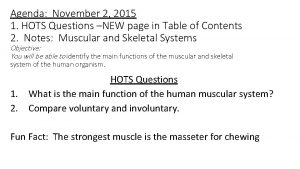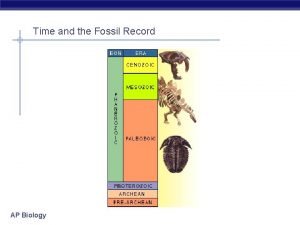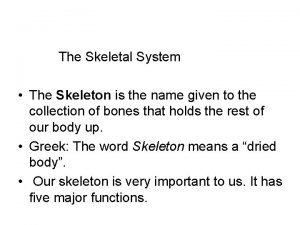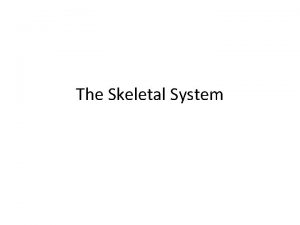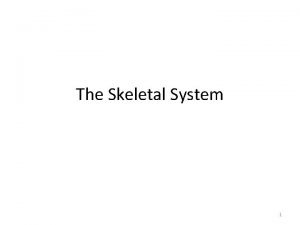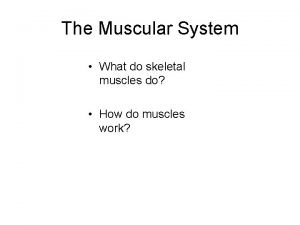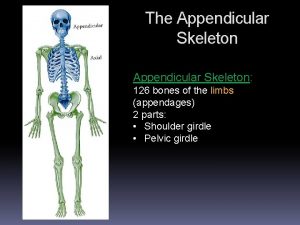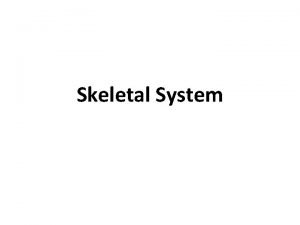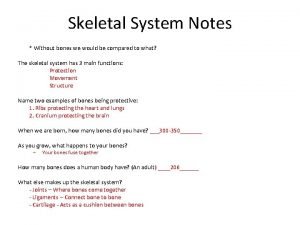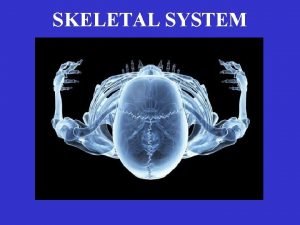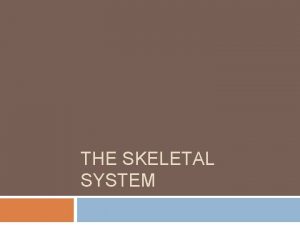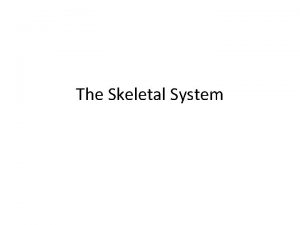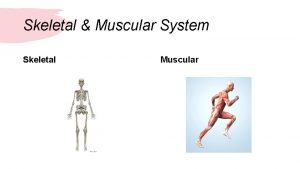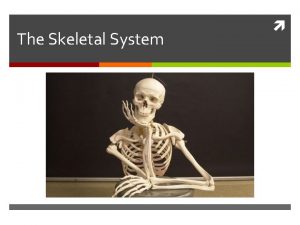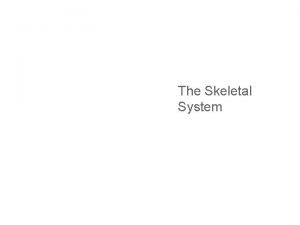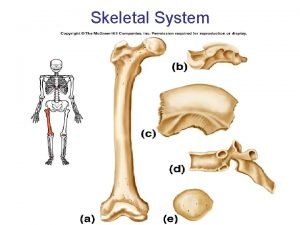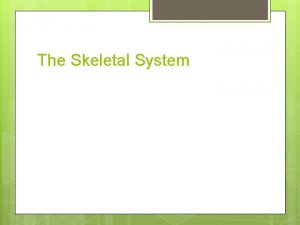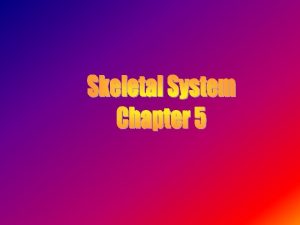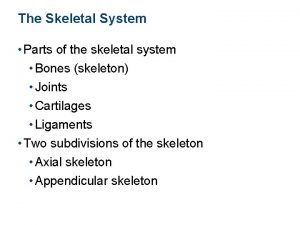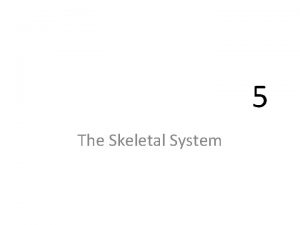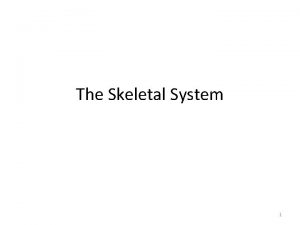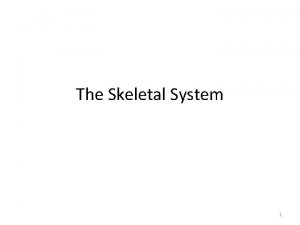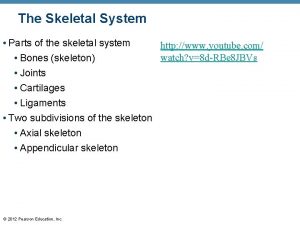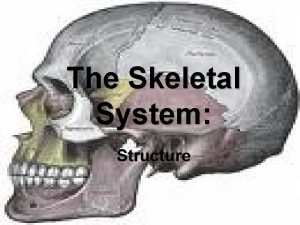The Skeletal System Parts of the skeletal system




















































- Slides: 52

The Skeletal System • Parts of the skeletal system • Bones (skeleton) • Joints • Cartilages • Ligaments © 2012 Pearson Education, Inc.

Functions of Bones • Support the body • Protect soft organs • Skull and vertebrae for brain and spinal cord • Rib cage for thoracic cavity organs • Allow movement due to attached skeletal muscles • Store minerals and fats • Calcium and phosphorus • Fat in the internal marrow cavity • Blood cell formation (hematopoiesis) © 2012 Pearson Education, Inc.

Bones of the Human Body • The adult skeleton has 206 bones • Two basic types of bone tissue • Compact bone • Homogeneous • Spongy bone • Small needle-like pieces of bone • Many open spaces © 2012 Pearson Education, Inc.

Spongy bone Compact bone © 2012 Pearson Education, Inc. Figure 5. 1

Classification of Bones on the Basis of Shape • Bones are classified as: • Long • Short • Flat • Irregular © 2012 Pearson Education, Inc.

© 2012 Pearson Education, Inc. Figure 5. 2

Classification of Bones • Long bones • Longer than they are wide • Shaft with heads situated at both ends • Contain mostly compact bone • All of the bones of the limbs (except wrist, ankle, and kneecap bones) • Example: • Femur • Humerus © 2012 Pearson Education, Inc.

© 2012 Pearson Education, Inc. Figure 5. 2 a

Classification of Bones • Short bones • Generally cube-shaped • Contain mostly spongy bone • Includes bones of the wrist and ankle • Sesamoid bones are a type of short bone which form within tendons (patella) • Example: • Carpals • Tarsals © 2012 Pearson Education, Inc.

© 2012 Pearson Education, Inc. Figure 5. 2 d

Classification of Bones • Flat bones • Thin, flattened, and usually curved • Two thin layers of compact bone surround a layer of spongy bone • Example: • Skull • Ribs • Sternum © 2012 Pearson Education, Inc.

Spongy bone Compact bone © 2012 Pearson Education, Inc. Figure 5. 1

© 2012 Pearson Education, Inc. Figure 5. 2 c

Classification of Bones • Irregular bones • Irregular shape • Do not fit into other bone classification categories • Example: • Vertebrae • Hip bones © 2012 Pearson Education, Inc.

© 2012 Pearson Education, Inc. Figure 5. 2 b

Anatomy of a Long Bone • Diaphysis • Shaft • Composed of compact bone • Epiphysis • Ends of the bone • Composed mostly of spongy bone © 2012 Pearson Education, Inc.

Articular cartilage Proximal epiphysis Diaphysis Distal epiphysis (a) © 2012 Pearson Education, Inc. Spongy bone Epiphyseal line Periosteum Compact bone Medullary cavity (lined by endosteum) Figure 5. 3 a

Anatomy of a Long Bone • Periosteum • Outside covering of the diaphysis • Fibrous connective tissue membrane • Perforating (Sharpey’s) fibers • Secure periosteum to underlying bone • Arteries • Supply bone cells with nutrients © 2012 Pearson Education, Inc.

Endosteum Yellow bone marrow Compact bone Periosteum Perforating (Sharpey’s) fibers Nutrient arteries (c) © 2012 Pearson Education, Inc. Figure 5. 3 c

Anatomy of a Long Bone • Articular cartilage • Covers the external surface of the epiphyses • Made of hyaline cartilage • Decreases friction at joint surfaces © 2012 Pearson Education, Inc.

Articular cartilage Compact bone Spongy bone (b) © 2012 Pearson Education, Inc. Figure 5. 3 b

Anatomy of a Long Bone • Epiphyseal plate • Flat plate of hyaline cartilage seen in young, growing bone • Epiphyseal line • Remnant of the epiphyseal plate • Seen in adult bones © 2012 Pearson Education, Inc.

Articular cartilage Proximal epiphysis Diaphysis Distal epiphysis (a) © 2012 Pearson Education, Inc. Spongy bone Epiphyseal line Periosteum Compact bone Medullary cavity (lined by endosteum) Figure 5. 3 a

Anatomy of a Long Bone • Marrow (medullary) cavity • Cavity inside of the shaft • Contains yellow marrow (mostly fat) in adults • In adults, red marrow is situated in cavities of spongy bone and epiphyses of some long bones © 2012 Pearson Education, Inc.

Articular cartilage Proximal epiphysis Diaphysis Distal epiphysis (a) © 2012 Pearson Education, Inc. Spongy bone Epiphyseal line Periosteum Compact bone Medullary cavity (lined by endosteum) Figure 5. 3 a

Bone Markings • Surface features of bones • Sites of attachments for muscles, tendons, and ligaments • Passages for nerves and blood vessels • Categories of bone markings • Projections or processes—grow out from the bone surface • Terms often begin with “T” • Depressions or cavities—indentations • Terms often begin with “F” © 2012 Pearson Education, Inc.

Microscopic Anatomy of Compact Bone • Osteon • A unit of bone • Central canal • Opening in the center of an osteon • Carries blood vessels and nerves © 2012 Pearson Education, Inc.

Osteon (Haversian system) Lamellae Blood vessel continues into medullary cavity containing marrow Spongy bone Perforating fibers Compact bone Periosteal blood vessel Periosteum (a) © 2012 Pearson Education, Inc. Central (Haversian) canal Perforating (Volkmann’s) canal Blood vessel Figure 5. 4 a

Microscopic Anatomy of Bone • Lamellae • Rings around the central canal • Sites of lacunae • Lacunae • Cavities containing bone cells (osteocytes) • Arranged in concentric rings called lamellae © 2012 Pearson Education, Inc.

Lamella Osteocyte (b) © 2012 Pearson Education, Inc. Canaliculus Lacuna Central (Haversian) canal Figure 5. 4 b

Osteon Lacuna © 2012 Pearson Education, Inc. (c) Central canal Interstitial lamellae Figure 5. 4 c

Formation of the Human Skeleton • In embryos, the skeleton is primarily hyaline cartilage • During development, much of this cartilage is replaced by bone • Cartilage remains in isolated areas • Bridge of the nose • Parts of ribs • Joints © 2012 Pearson Education, Inc.

Bone Growth (Ossification) • Epiphyseal plates allow for lengthwise growth of long bones during childhood • New cartilage is continuously formed • Older cartilage becomes ossified • Bone replaces cartilage through the action of osteoblasts © 2012 Pearson Education, Inc.

Bone Growth (Ossification) • Bones are remodeled and lengthened until growth stops • Bones are remodeled in response to two factors • Blood calcium levels • Pull of gravity and muscles on the skeleton • Bones grow in width (called appositional growth) © 2012 Pearson Education, Inc.

Bone starting to replace cartilage Bone collar Hyaline cartilage model In an embryo © 2012 Pearson Education, Inc. Figure 5. 5, step 1

Hyaline cartilage New center of bone growth Medullary cavity Invading Growth blood in bone vessels length In a fetus © 2012 Pearson Education, Inc. Figure 5. 5, step 2

Articular cartilage Spongy bone New bone forming Epiphyseal plate cartilage Growth in bone width Invading blood vessels New bone forming Epiphyseal plate cartilage In a child © 2012 Pearson Education, Inc. Figure 5. 5, step 3

Bone growth Bone grows in length because: 1 Cartilage grows here. 2 Cartilage is replaced by bone here. 3 Cartilage grows here. 4 Cartilage is replaced by bone here. © 2012 Pearson Education, Inc. Bone remodeling Growing shaft is remodeled as: Articular cartilage Epiphyseal plate 1 Bone is resorbed here. 2 Bone is added by appositional growth here. 3 Bone is resorbed here. Figure 5. 6

Types of Bone Cells • Osteocytes—mature bone cells • Osteoblasts—bone-forming cells • Osteoclasts—giant bone-destroying cells • Break down bone matrix for remodeling and release of calcium in response to parathyroid hormone • Bone remodeling is performed by both osteoblasts and osteoclasts © 2012 Pearson Education, Inc.

Bone Fractures • Fracture—break in a bone • Types of bone fractures • Closed (simple) fracture—break that does not penetrate the skin • Open (compound) fracture—broken bone penetrates through the skin • Bone fractures are treated by reduction and immobilization © 2012 Pearson Education, Inc.

Repair of Bone Fractures • Hematoma (blood-filled swelling) is formed • Break is splinted by fibrocartilage to form a callus • Fibrocartilage callus is replaced by a bony callus • Bony callus is remodeled to form a permanent patch © 2012 Pearson Education, Inc.

Hematoma External callus New blood vessels Internal callus (fibrous tissue and cartilage) 1 Hematoma forms. © 2012 Pearson Education, Inc. Bony callus of spongy bone Healed fracture Spongy bone trabecula 2 Fibrocartilage callus forms. 3 Bony callus forms. 4 Bone remodeling occurs. Figure 5. 7

Developmental Aspects of the Skeletal System • At birth, the skull bones are incomplete • Bones are joined by fibrous membranes called fontanels • Fontanels are completely replaced with bone within two years after birth © 2012 Pearson Education, Inc.

Parietal bone Frontal bone of skull Mandible Occipital bone Clavicle Scapula Radius Ulna Humerus Femur Tibia Ribs Vertebra Hip bone © 2012 Pearson Education, Inc. Figure 5. 34

Skeletal Changes Throughout Life • Fetus • Long bones are formed of hyaline cartilage • Flat bones begin as fibrous membranes • Flat and long bone models are converted to bone • Birth • Fontanels remain until around age 2 © 2012 Pearson Education, Inc.

Skeletal Changes Throughout Life • Adolescence • Epiphyseal plates become ossified and long bone growth ends • Size of cranium in relationship to body • 2 years old—skull is larger in proportion to the body compared to that of an adult • 8 or 9 years old—skull is near adult size and proportion • Between ages 6 and 11, the face grows out from the skull © 2012 Pearson Education, Inc.

© 2012 Pearson Education, Inc. Figure 5. 35 a

Skeletal Changes Throughout Life • Curvatures of the spine • Primary curvatures are present at birth and are convex posteriorly • Secondary curvatures are associated with a child’s later development and are convex anteriorly • Abnormal spinal curvatures (scoliosis and lordosis) are often congenital © 2012 Pearson Education, Inc.

© 2012 Pearson Education, Inc. Figure 5. 18

Skeletal Changes Throughout Life • Osteoporosis • Bone-thinning disease afflicting • 50 percent of women over age 65 • 20 percent of men over age 70 • Disease makes bones fragile and bones can easily fracture • Vertebral collapse results in kyphosis (also known as dowager’s hump) • Estrogen aids in health and normal density of a female skeleton © 2012 Pearson Education, Inc.

© 2012 Pearson Education, Inc. Figure 5. 36

© 2012 Pearson Education, Inc. Figure 5. 37
 Parts of skeletal system
Parts of skeletal system What are the five functions of the skeletal system
What are the five functions of the skeletal system Medical terminology skeletal system
Medical terminology skeletal system Skeletal system
Skeletal system The skeletal system learning exercises
The skeletal system learning exercises Chapter 7:4 skeletal system label the skeleton
Chapter 7:4 skeletal system label the skeleton Chapter 5 the skeletal system figure 5-13
Chapter 5 the skeletal system figure 5-13 Section 36-1 the skeletal system
Section 36-1 the skeletal system What are the five functions of the skeletal system?
What are the five functions of the skeletal system? Human body theme park
Human body theme park Dem crazy bones skeleton template
Dem crazy bones skeleton template Chapter 6 the skeletal system answer key
Chapter 6 the skeletal system answer key Site:slidetodoc.com
Site:slidetodoc.com Chapter 32 section 2 the skeletal system answer key
Chapter 32 section 2 the skeletal system answer key Nervous system amusement park project
Nervous system amusement park project Skeletal system 5 main functions
Skeletal system 5 main functions Navigating the body muscular system #3
Navigating the body muscular system #3 How to care for the skeletal system
How to care for the skeletal system Crash course skeletal system
Crash course skeletal system Whats the main function of the skeletal system
Whats the main function of the skeletal system Chapter 8 skeletal system
Chapter 8 skeletal system Chapter 7:4 skeletal system
Chapter 7:4 skeletal system Axial skeleton skull worksheet chapter 5
Axial skeleton skull worksheet chapter 5 The axial skeleton forms the longitudinal axis of the body
The axial skeleton forms the longitudinal axis of the body Skeletal system
Skeletal system Axial skeleton vs appendicular skeleton
Axial skeleton vs appendicular skeleton Muscoloskeletal system
Muscoloskeletal system Burs skeletal word
Burs skeletal word Homeostatic imbalances of the skeletal system
Homeostatic imbalances of the skeletal system Chapter 5 the skeletal system figure 5-13
Chapter 5 the skeletal system figure 5-13 Human skull superior view
Human skull superior view Chapter 5 the skeletal system
Chapter 5 the skeletal system Receive
Receive Chapter 3 the skeletal system labeling exercises
Chapter 3 the skeletal system labeling exercises Chapter 5 the skeletal system figure 5-13
Chapter 5 the skeletal system figure 5-13 Tissue examples
Tissue examples Skeletal system
Skeletal system Skeletal system
Skeletal system Hyoid location
Hyoid location Somatic vs autonomic nervous system
Somatic vs autonomic nervous system Chapter 8 skeletal system
Chapter 8 skeletal system Learning objectives of skeletal system
Learning objectives of skeletal system Skeletal system
Skeletal system Hots questions on skeletal system
Hots questions on skeletal system Skeletal system
Skeletal system Skeletal system
Skeletal system Skeletal system
Skeletal system Introduction of skeletal system
Introduction of skeletal system Growth plate
Growth plate Major skeletal muscles
Major skeletal muscles 126 bones of the appendicular skeleton
126 bones of the appendicular skeleton Skeletal system
Skeletal system Skeletal system notes
Skeletal system notes

